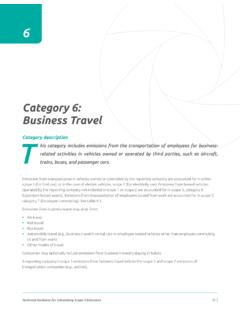Transcription of Understanding Crowd Behaviours - GOV.UK
1 Emergency Planning College Understanding Crowd Behaviours : Supporting Evidence This report has been commissioned by, and prepared for, the Cabinet Office It forms part of the Understanding Crowd Behaviour' research report series. The research was sponsored and funded by the Cabinet Office, as part of the canon of civil protection literature and guidance, published on their UK. Resilience website: ( ). The research was carried out, and the report series produced, by Organisational Psychologists at the Centre for Socio-Technical Systems Design (CSTSD) and the Centre for Organisational Strategy, Learning and Change (COSLAC) at Leeds University Business School.
2 ( ). ( ). Rose Challenger, BSc, MSc Researcher in Organisational Psychology Professor Chris W. Clegg, BA, MSc, FBPsS, FBCS, FRSA. Professor of Organisational Psychology Mark A. Robinson, BSc, MSc Researcher in Organisational Psychology The research was project managed by the Emergency Planning College, on behalf of the Cabinet Office. Mark Leigh BA, MSc, MA. Consulting Editor For further information, please contact: The Cabinet Office Emergency Planning College The Hawkhills Easingwold York YO61 3EG. Tel: 01347 825000. Email: Crown Copyright 2009. ISBN 978-1-874321-24-8. Published: June 2009. ii DISCLAIMER. Please note, the recommendations made in this report regarding good practice for event preparation and Crowd management are an interpretation of best practice made on the basis of knowledge and expertise gained from literature and interviews.
3 They are not definitive rules of event preparation and Crowd management. iii Contents Contents List of Figures viii List of Tables x Foreword xi Acknowledgements xiii A Guide for Readers xv Executive Summary 1. Part 1 Very Large Scale Crowd Events 10. Crowd Behaviours at Very Large Scale Events 12. Differences at Very Large Scale Events 14. New and Additional Potential Risks at Very Large 16. Scale Events Part 2 A Cautionary Tale: Heathrow Terminal 5 (T5) 22. The Opening of T5 24. Evolution of the T5 Debacle 26. Inter-Related Factors and Knock-On Effects at T5 29. Contributory Factors to the T5 Debacle 34. Technology and Software Failures 36.
4 Inefficient Staff Training and Familiarisation 37. Lack of New System Testing 39. Staff Delays 41. Incomplete Building 42. Lack of End-User Involvement 43. Inflexible Management Style 45. Poor Industrial Relations 47. Failure to Learn Lessons 49. Lack of a Systems Approach 51. Recommendations for Crowd Events from the T5 Debacle 52. Part 3 Review of the Literature 54. iv Literature on Crowd Behaviours 56. Neglect in the Literature 58. Defining a Crowd 59. A Crowd ' Defining Criteria 62. Key Learning Points 69. Types and Characteristics of Crowds 70. Types of Crowds 70. Characteristics of Crowds 73. Decision Making in Crowds 75.
5 Crowd Management versus Crowd Control 76. Key Learning Points 78. Key Theories of Crowd Behaviours 79. Acknowledgement of Theoretical Evolution 80. Classic Theories 81. Game Theory 84. Deindividuation Theory 86. Social Facilitation Theory 90. Social Loafing Theory 93. Emergent Norm Theory 95. Minimal Group Paradigm 98. Social Identity Theory 100. Self-Categorisation Theory 103. Social Identity Model of Crowd Behaviour 106. Elaborated Social Identity Model of Crowd Behaviour 110. Social Identity Model of Deindividuation Effects 117. Place Scripts 121. Key Learning Points 125. Moderators of Crowd Influence on Individual Behaviours 128.
6 Moderators of Crowd Influence on Members' Behaviours 129. Stable Moderators of Crowd Influence 130. Situational Moderators of Crowd Influence 132. Key Learning Points 135. Literature on Crowd Behaviours in Emergencies 137. Theories of Crowd Behaviours in Emergencies 139. Mass Panic 140. Affiliation and Normative Models 144. Social Identity/Self-Categorisation Approach 146. Key Learning Points 148. Emergency Evacuations 149. Interpretation 150. Preparation 153. Action 154. Key Learning Points 160. Literature on Relevant Crowd Disasters 161. The Importance of Examining Crowd Disasters 163. Reasons for Crowd Disasters 165. Failure to Learn from Crowd Disasters 168.
7 Hillsborough Football Stadium Disaster (1989) 170. Evolution of the Disaster 170. Reasons for the Disaster 173. v Contents King's Cross Underground Fire (1987) 179. Evolution of the Disaster 179. Reasons for the Disaster 181. Bradford Football Fire Disaster (1985) 184. Evolution of the Disaster 184. Reasons for the Disaster 185. Hajj Pilgrimage Disaster (2006) 186. Evolution of the Disaster 188. Reasons for the Disaster 189. Key Learning Points 190. Literature on Simulating Crowd Behaviours 191. Crowd Models and Simulations 193. Main Ideas 193. Types of Crowd Simulation Model 194. Macroscopic Models 195. Fluid Dynamics Models 196.
8 Microscopic Models 198. Rule-Based Models 199. Social Forces Models 201. Self-Organisation Phenomenon 205. Cellular Automata Models 215. Agent-Based Models 218. Evacuation Models 228. EXODUS 230. SIMULEX 231. Future Simulation Models 232. Key Learning Points 235. Gaps in Current Research Literature 238. Types of Crowds 240. Stewarding of Crowds 241. Non-Ticketed Event Crowds 242. Part 4 Expert Interview Findings 243. The Expert Interviewees 245. Experienced Police Officers 247. Key Practitioners 247. Leading Academics 248. Key Interview Findings 249. Types of Crowd 251. Key Lessons and Good Practice Advice for Crowd Events 255.
9 Planning and Preparations 256. Multi-Agency Teamwork 260. Communication and Information 263. Understanding the Crowd 265. Experienced Personnel 268. Command and Control 269. Observing and Monitoring 271. vi Key Risks Involved with Crowd Events 272. Debriefing 273. Key Learning Points 274. Appendix: References 276. vii List of Figures List of Figures Figure 1. The potential risks associated with very large scale events 21. from a systems perspective Figure 2. The problematic Terminal 5 opening from a systems perspective 33. Figure 3. A density distribution of 40 people per 10 square metres 63. Figure 4. A density distribution of 20 people per 10 square metres 64.
10 Figure 5. A density distribution of 84 people per 10 square metres 65. Figure 6. Visual representation of Fruin's levels of service 67. Figure 7. Arching effect observed as Crowd members try to pass 141. through a narrow exit Figure 8. The Leppings Lane end of Hillsborough 171. Figure 9. Perspective of the police at Hillsborough 176. Figure 10. Perspective of event administrators at Hillsborough 177. Figure 11. Perspective of supporters at Hillsborough 178. Figure 12. Diagram of King's Cross Underground 180. Figure 13. Layout of the Jamarat Bridge 188. Figure 14. Severe overcrowding during the Hajj 189. Figure 15. Reynolds' (1987) boids' model 199.















